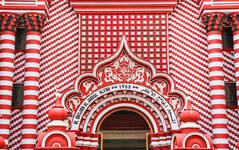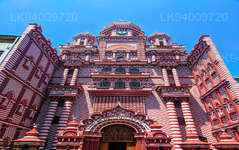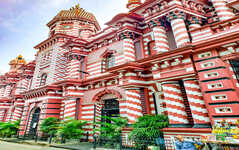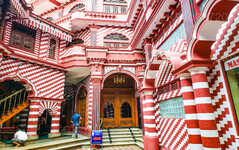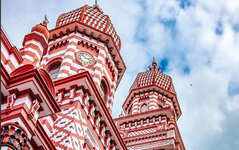
Colombo-stad
Colombo, de hoofdstad van Sri Lanka, is een dynamische stad die traditie en moderniteit combineert. Je vindt er koloniale architectuur, levendige markten en serene boeddhistische tempels. Met een gevarieerde keuken, een groeiende skyline en prachtige stranden is het een bruisend centrum voor zaken, cultuur en toerisme, en een ideale uitvalsbasis om de wonderen van Sri Lanka te verkennen.
Red Mosque
The Jami Ul-Alfar Mosque, also known as the Red Mosque (not to be confused with the Red Mosque of New Delhi), is one of Colombo’s oldest mosques. The Arabs arrived for the first time in Sri Lanka for trade in the 7th century AD. As olden days Ceylon was a hub for trade and was right in the middle of the spice and silk routes; they maintained a constant presence in Sri Lanka since that time by either migrating or intermarrying with the locals. Most Islamic communities settled in Colombo or Galle where the main ports were located; and to this day their descendants continue their lives in these areas. And hence as a result Colombo, with its being a major trade zone of the country, has a very big population of Muslims. But there was a severe lack of large mosques, which made life very difficult for the local Islamic community as their religion enforced praying 5 times a day.
The Jami Ul-Alfar Mosque was built in 1908 in Pettah to cater to the growing need for a large place for religious repose. The design and construction were done by Habibu Labbe Saibu Labbe an unknown architect of the time. He used Indo-Saracenic structural images, given to him by the South Indian traders who commissioned him, as his base; but also mixed in elements of his own. One of the most notable architectural changes is that the dome-shaped spires on top of the mosque are not of the typical onion shape. Instead, its shape follows that of a pomegranate; while its walls are painted the same shade of red as the innards of that fruit, along with pale yellow horizontal stripes. This red tone is why the mosque gained its nickname. The mosque had approximately two floors (unsure of the exact amount as renovations were done later, and the locals in the know-how refuse to speak much about its history) at the time; which were supported by four massive teak tree columns that pass through the two lower floors.The construction was completed in 1909 and the mosque could hold a capacity of 1500 people; though only about 500 attended regularly there at that time. However, the numbers grew swiftly and in 1975 the Haji Omar Trust took control of the surrounding properties and began the work of expanding the mosque.
In 2007, there was a new four-storied wing built, allowing the mosque to increase its capacity to 10,000. Today the mosque continues to update and refurbish its facilities.
Visitors are greeted by beautiful minarets and spires straight from a Persian fairytale, which is seen for miles all around. The bright red and pale yellow stripes of its walls make the mosque stand out in the crowded street with all its shops and buildings of trade and business. The tiles of the inner part of the mosque have been replaced with those that have an early 20th century Period design; which gives the entire area a beautifully aged aura. The four teak support columns are still there in pristine condition. The mosque doesn’t skimp on modern-day facilities though; and was most recently having an escalator facility built for elderly and infirm visitors.
However, there seems to be a ban on Muslim women to visit the mosque due to religious restrictions. As there have been many who requested a section for the women; there appears to plan for such a section, where women can do their prayers, to be built in the future.
Though the Red Mosque is an Islamic religious facility, visitors from other religions are eagerly welcomed.
Over het district Colombo
Colombo is de grootste stad en commerciële hoofdstad van Sri Lanka. Het ligt aan de westkust van het eiland en grenst aan Sri Jayewardenepura Kotte, de hoofdstad van Sri Lanka. Colombo is een drukke en levendige stad met een mix van modern leven en koloniale gebouwen en ruïnes, en een stadsbevolking van 647.100. De metropoolregio Colombo, gedefinieerd door de districten Colombo, Gampaha en Kalutara, heeft een geschatte bevolking van 5.648.000 en beslaat een oppervlakte van 3.694,20 km². Colombo is een multi-etnische, multiculturele stad. Het is de meest bevolkte stad van Sri Lanka, met 642.163 mensen die binnen de stadsgrenzen wonen. De bevolking van Colombo is een mix van verschillende etnische groepen, voornamelijk Singalezen, Moren en Tamils. Er wonen ook kleine gemeenschappen van mensen met Chinese, Portugese, Nederlandse, Maleisische en Indiase afkomst in de stad, evenals talloze Europese expats. De overgrote meerderheid van de Sri Lankaanse bedrijven heeft hun hoofdkantoor in Colombo. Enkele van de industrieën die er actief zijn, zijn chemie, textiel, glas, cement, lederwaren, meubels en sieraden. In het stadscentrum staat het op één na hoogste gebouw van Zuid-Azië: het World Trade Centre.
Over de Westelijke Provincie
The Western Province is the most densely populated province of Sri Lanka. It is home to the legislative capital Sri Jayawardenepura Kotte as well to Colombo, the nation's administrative and business center. Western Province is divided into 3 main districts called Colombo (642 km²), Gampaha (1,386.6 km²) and Kalutara (1,606 km²) districts. As Sri Lanka's economic hub, all the major local and international corporations have their presence in the city and so do all the major designer and high street retailers, so be ready to indulge in some retail therapy in western province.
Having the highest population in the all the provinces, the almost all the premier educational institutions in the island are located in western province. Universities in the province include the University of Colombo, the University of Sri Jayewardenepura, University of Kelaniya, Open University, Sri Lanka, Buddhist and Pali University of Sri Lanka, General Sir John Kotelawala Defence University and University of Moratuwa .Western province has the largest amount of schools in the country, which includes National, Provincial, Private and International schools.

